The question of which crochet stitch uses the least yarn is commonly asked but not well-researched. In this post, I will provide the results of my completed experiments to answer this exact question for the basic crochet stitches and some common lacy crochet stitches.
So, which crochet stitch uses the least yarn of basic crochet stitches and of lacy crochet stitches? Of the basic crochet stitches (single, half-double, double, and treble crochet), the treble crochet stitch and the double crochet stitch used the least amount of yarn. They tied in length and weight of yarn used for a 4 by 4-inch swatch. Of the common lacy crochet stitches tested, the Solomon’s Knot uses the least amount of yarn.
When picking a crochet pattern, you may want to consider the amount of yarn different stitches use for a variety of reasons. After doing this experiment, I know I can apply the results to my future work! Below, I will describe the crochet stitch comparison experiments and give you some practical advice on how to use the results to your advantage.
Here is the basic information in video format! 😀
Keep reading for more details. I will also provide the information about the stitches I chose to compare and how to crochet them!
Results of the Basic Crochet Stitch Yarn Usage Experiment
So, for the basic crochet stitches, I chose an inexpensive size 4 yarn. I decided to crochet a 4 by 4-inch swatch with a 5.5 mm hook because this is the gauge guide that was provided on the packaging.
I crocheted a swatch for each stitch listed. I ensured that the swatch sizes were the same once completed. I also cut the tails to a consistent 3 inches on each swatch.
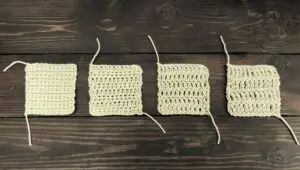
Once they were completed, I frogged (ripped out) each swatch. I measured the length and the weight of each pile of yarn.
Here is a table with the results.
| Stitch | Number of Stitches | Number of Rows | Length of Yarn Used | Weight of Yarn Used* |
|---|---|---|---|---|
| Single Crochet | 12 | 13 | 479 inches | 8 grams |
| Half-Double Crochet | 12 | 8 | 421 inches | 7 grams |
| Double Crochet | 12 | 6 | 395 inches | 6 grams |
| Treble Crochet | 12 | 4 | 395 inches | 6 grams |
The result of the basic crochet stitch yarn usage experiment showed that the Double and Treble Crochet used the exact same amount of yarn for a 4 by 4-inch square of crochet! Both of these stitches used 17.5% less yarn than the Single Crochet and 6% less than the Half-double Crochet.
Results of the Lace Crochet Stitch Yarn Usage Experiment
This was a little more tricky to plan. First, I had to choose what lace stitches to compare. This was difficult because there are literally thousands of lace patterns out there! I had to narrow it down.
I looked at what some classic lace stitches are and the ones that have actual names. There are so many variations that just say, “lace crochet pattern.” I ruled these out. Then, I chose stitches that repeat versus a “pattern.”
After finding a variety of options, I narrowed it down to Solomon’s knot, Basic Filet Crochet, and the Trellis Stitch. I chose these three because they do not have any clusters of the basic crochet stitches. I already know that that type of lace stitch would take more yarn. These are all very “meshy” stitches.
Once I chose my stitches, I did the same thing that I did for the basic crochet stitch comparison, making a 4 by 4-inch swatch with a 5.5 mm hook of a size 4 yarn with each stitch and cutting the tails to a consistent 3 inches.

Once they were completed, I frogged each swatch and measured the length and the weight of each pile of yarn.
Here is a table with the results.
| Stitch | Number of repeats | Number of Rows | Length of Yarn Ues | Weight of Yarn Used |
|---|---|---|---|---|
| Solomon’s Knot | 4 | 5 | 187 inches | 3 grams |
| Filet Crochet | 5 | 5 | 244 inches | 4 grams |
| Trellis Stitch | 3 | 7 | 230 inches | 4 grams |
The result of the lace crochet stitch yarn usage experiment showed that the Solomon’s Knot used the least amount of yarn for a 4 by 4-inch square of crochet. The Solomon’s Knot used 23% less yarn than Filet Crochet and 19% less than the Trellis Stitch!
Why Did I do the Crochet Stitch Yarn Usage Comparison Experiment?
When I researched the question of which stitch uses the least yarn, I found a few answers for the basic crochet stitches. Most were based on poll questions or online forums, and they conflicted between the double crochet and the treble crochet stitch.
I found two resources that crocheted swatches and compared the amount of yarn used for each basic stitch.
One completed the swatches and put pictures but did not give the exact results, only stated that the treble crochet stitch used the least. In the other, the crochet swatches pictured were very inconsistent in size and tension, and I felt that may have impacted the results.
I found ZERO resources about lace crochet stitches! Only general statements of lace/open work use less than the basic crochet stitches.
Because of the conflict about basic crochet stitches and the lack of resources about lace crochet stitches (and because I like scientific design; it is the physical therapist and researcher in me), I knew I HAD to do the experiment myself!
I also knew I needed to determine how and when to apply this knowledge to my crochet projects!
How do You Make the Crochet Stitches that use Less Yarn?
I’ll give you a description of how to crochet each of the basic crochet stitches (because they build on each other). Then you will know how to crochet the stitch that uses the least yarn, too! All these stitches are a series of yarn overs and pulling through stitches or loops on the hook, just a different number of times for each stitch!
- Single Crochet (SC): Insert hook, yarn over, draw through stitch, yarn over, draw through two.
- The Spruce Crafts provides a detailed post with a video tutorial here if you are a beginner looking to learn this stitch!
- Half-Double Crochet (HDC): Yarn over, insert hook, yarn over, draw through stitch, yarn over, draw through all three loops on your hook.
- The Spruce Crafts provides a detailed post with a video tutorial here.
- Double Crochet (DC): Yarn over, insert hook, yarn over, draw through stitch, yarn over, draw through two loops, yarn over, draw through last two loops.
- The Spruce Crafts provides a detailed post with a video tutorial here.
- Treble Crochet (TC): Yarn over twice, insert hook, yarn over, draw through stitch, yarn over, draw through two loops, yarn over, draw through two loops, yarn over, draw through last two loops.
- The Spruce Crafts provides a detailed post with a step-by-step picture tutorial here.
The lace crochet stitches are more about repeats, so they are slightly longer to explain.
- Solomon’s knot (SK):
- Row 1-chain two, SC in 2nd chain from hook, draw up a loop to your height (usually 1/2 to 1 1/4 inch), *yarn over, draw through loop, insert hook back into large loop, yarn over, draw through large loop, yarn over, draw through last 2 loops on hook up to your height*. Repeat * to * until your row is the length of your project.
- Row 2-turn work, SC into 4th SC from hook, *work two SK (as described above), SC into next SC*. Repeat * to * until end of row.
- Here is a GREAT YouTube Tutorial on how to complete the Solomon’s Knot stitch from NewStitchADay.com! It makes a lot more sense in video format!
- Filet Crochet:
- Row 1-DC in 8th chain from hook, *Ch 2, skip next 2 chains, DC in next chain*, repeat * to * to end of row. Turn.
- Row 2-Chain 5 (counts as 1st DC), *skip chain gap, DC in next DC, Ch 2* repeat * to * to end of row, DC in third chain of previous turning chain.
- This tutorial from Bluprint.com is helpful with pictures. There are tons of variations because this is used to make negative space pictures with adding more DCs, I did the basic open work stitch only.
- Trellis Stitch:
- Row 1-SC in 6th chain from hook, *chain 5, skip 3 chains, SC in next chain*, repeat * to * to end, turn.
- Row 2-*Chain 5, SC in chain space*, repeat * to * to the end, turn.
- Repeat rows 2 until length desired.
- Here is a YouTube tutorial for this pattern. The quality is so-so, but it is the only one that I found that actually shows how to end each row, so it is very valuable!
Why Do Certain Crochet Stitches Use Less Yarn?
Basically, for the single crochet stitch, most of it overlaps with the previous row, with very little height added on each row. This is seen by the number of rows it took to get to 4 inches (13).
If you look at the swatch, there is very little space or air between stitches, making a denser pattern. This logically will take more yarn (which was confirmed). Same with the half double crochet, though it is taller, so it only took 8 rows for 4 inches.
Now when looking at the swatches for the double and treble crochet stitches, they both have significantly more height to each stitch and have more space or air between and within stitches. The treble appears to have a little more “airiness” to it, so I thought it would actually have less yarn. Well, the results showed otherwise.
Now when looking at the swatches for the double and treble crochet stitches, they both have significantly more height to each stitch and have more space or air between and within stitches. The treble appears to have a little more “airiness” to it, so I thought it would actually have less yarn. Well, the results showed otherwise.
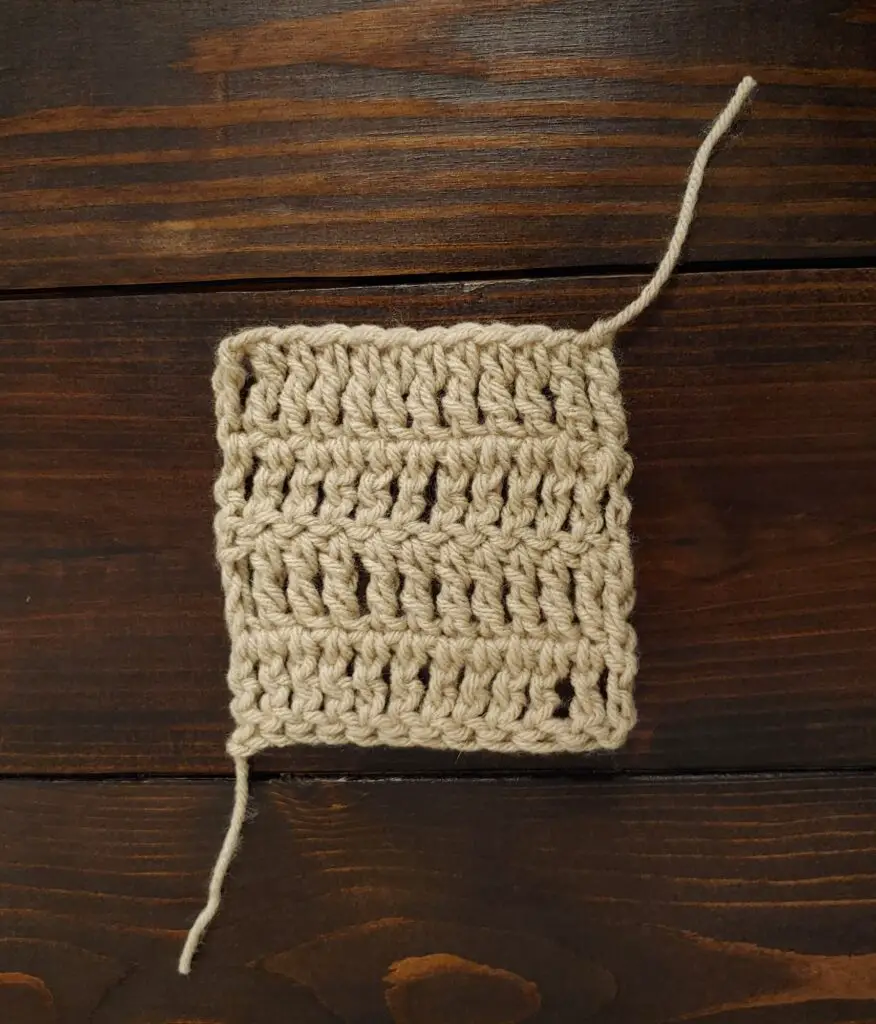
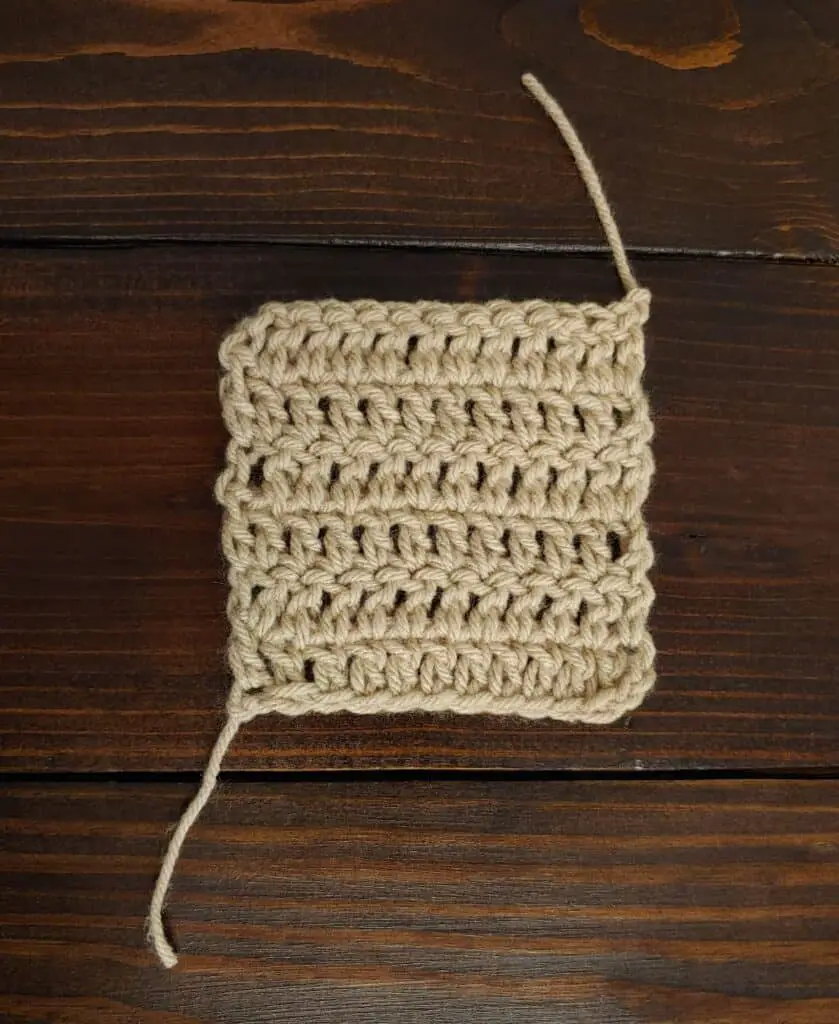
After pondering it, I still think that the treble crochet may use a tiny bit less yarn. For both the double and treble stitches, you are inserting your hook one time through the previous row, then adding height; so if you have more rows, it should be more yarn used due to more overlap. The double crochet requires more rows to achieve the same height, so it should take slightly more yarn. The difference is likely so minuscule, though, that it would be negligible even for a large afghan.
Lace stitches have significantly more “air” in the patterns and, therefore, will take less yarn than a more solid stitch. The combination of chains that don’t overlap at all with a few slip stitches, single crochets, or double crochets that do overlap to create structure definitely decreases the amount of yarn required to make the same size piece.

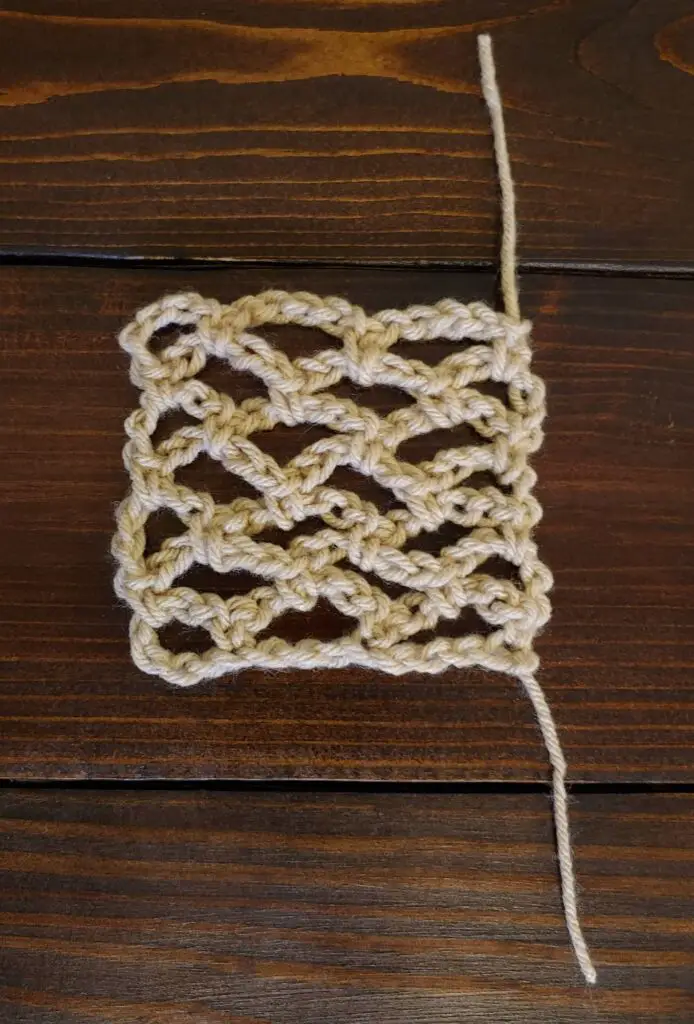
The minimal difference between Filet Crochet and the Trellis Stitch makes sense to me by just looking at the swatches. They both have approximately the same size spaces and have about the same number of total overlaps/connections to the previous rows.
The difference between the Solomon’s Knot and the other two tested actually really surprised me! I did expect it to be a little bit less yarn by the way it looked, but not as huge of a difference as it was.
The Solomon’s Knot pattern overlaps very little with previous rows and ends up with very wide spaces between each connection to the previous row. This makes it the ideal stitch for yarn conservation!
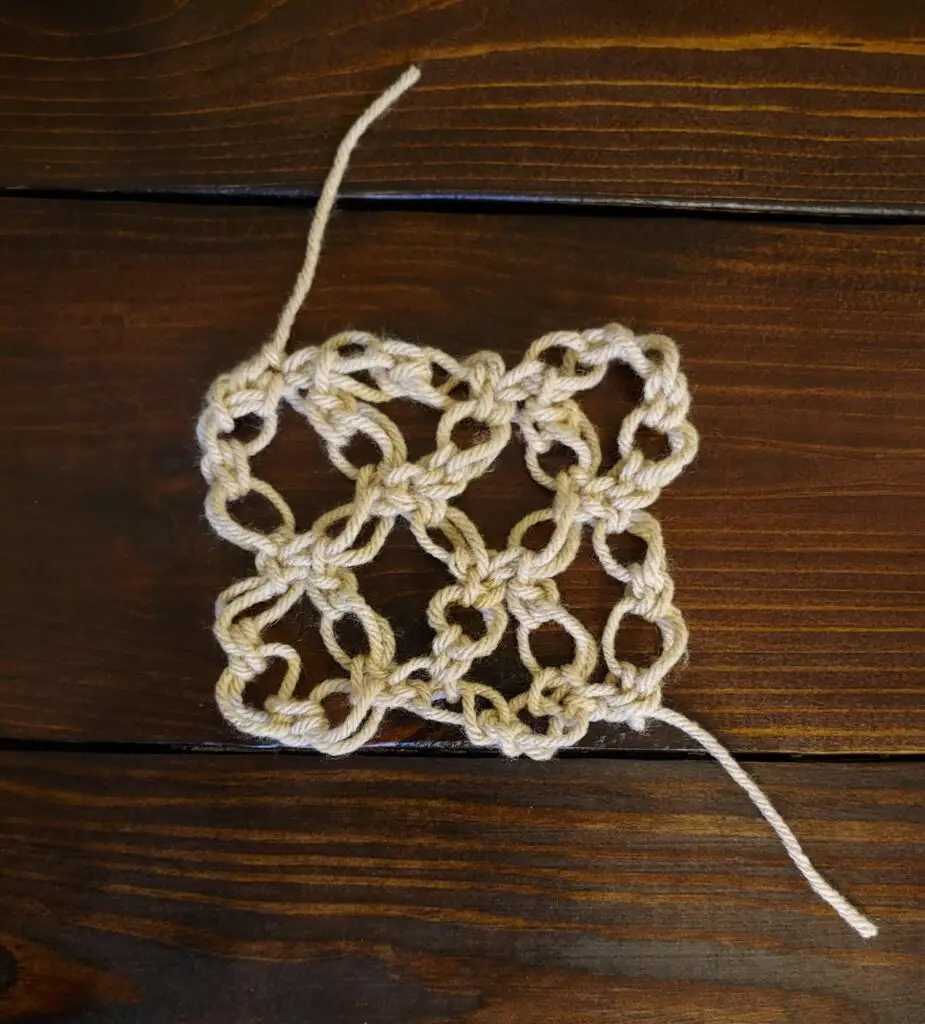
Why is it Good to Know Which Stitches Use the Least Yarn??
I am all about frugality! Crochet can be very expensive because of the amount of yarn you need to create large projects. If you want to save some money but still make a gorgeous project, you’d like to use a stitch that conserves yarn!
If you compare the stitch that uses the least from this experiment, Solomon’s Knot, to the stitch that uses the most, Single Crochet, Solomon’s Knot uses 61% less yarn!!! That is a HUGE difference! Imagine the money savings from using 61% less yarn for the same-sized project!
Another frugality reason you may want to use a yarn-conserving stitch is that you fell in love with some very expensive yarn that you HAD to have! In this case, you may want to choose Solomon’s Knot to end up with something larger without having to buy many skeins of that expensive yarn.
What if you have a little bit of yarn leftover from a project that you want to use for a complete project? You definitely would need to know some yarn-conserving stitches! In this case, an openwork pattern may be the way you go!
Things to Think About Besides Using the Least Yarn
So we know that we want to conserve yarn…why not just always use the Solomon’s Knot? Well, we can’t ONLY think about using the absolute least amount of yarn!
For example, if you are making a blanket, you would probably want to go with one of the more “dense” stitches, right? So you aren’t going to use the Solomon’s Knot. You would still be very cold! You could, however, choose a double or treble crochet pattern versus a half double or single crochet pattern to get more bang for your yarn buck!
On the other hand, If you were making clothing or scarves or other accessories, you could easily go with a lacy, openwork pattern!
For that very expensive yarn, you may choose to make a very fancy (but not warm!) shawl to wear on a formal or semi-formal occasion with an openwork stitch. For that, you could choose Solomon’s Knot to stretch your yarn the farthest!
For the stash-busting project, you may want to go with a light springtime cowl, again with an openwork pattern.
A time when you may not want to focus on conserving yarn would be for something like a baby blanket. For safety reasons, it is good to use a more dense stitch to avoid little fingers getting twisted in the stitches and potentially cutting off circulation! So something like single or half double crochet, or even something denser like popcorn or bobble stitches might be more appropriate.
One Caveat to this Experiment About Stitches that Use the Least Yarn
I have specified that these experiments looked at crocheting a complete project with length and height (my swatches were 4 by 4-inch squares). BUT…What if you are ONLY going for length?!
Technically, chain stitches, slip stitches, and single crochets (in that order) use the least amount of yarn for the same number of stitches. In my experiment, you can see that 12 stitches were 4 inches long regardless of the stitch used. Because chains, slip stitches, and single crochets are shorter, for a single row they use less yarn.
So…if you have a very small amount of a certain yarn left, you could make a chain necklace or earrings as stash busters.
Or, if you are doing a stash-busting striped blanket, you could do one row of single crochet with the color of yarn you have the least of and save the taller stitch rows for the yarns you have more of.
If you want to know which textured crochet stitch uses the MOST yarn check out “What Crochet Stitch Uses the Most Yarn and Why You Would Want to Know!”
If you want to know which basic stitch will work up the FASTEST, check “What Crochet Stitch Works Up Fastest? I Need to Make a Quick Blanket!”
Well, I could go on and on, but basically, I think I’ve covered it! You have your answer! If you think of any other questions about it, drop me a comment, and I will answer the best I can!
Now it is time for YOU to get Crafty with Ashy! Show me YOUR lace or basic crochet stitch creations in the comments!
Be sure to subscribe and follow me so you don’t miss any inspiration!
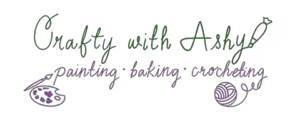


I looked and looked, and I think you’re the only one who’s actually got data for this question, so many thanks for that.
Now, what I was wondering in the first place was whether the William Elmore extended double crochet actually does, as he purportedly wrote, use less yarn than a standard double crochet, *based on finished swatch size*, exactly as you’ve done here.
(In case you or anyone reading hasn’t heard of this, it’s just an added yarn-over and through one loop before finishing the stitch in exactly the same way as a regular double, so it’s taller, but not as tall as a treble.)
Hoping you’d be willing to try that sometime, and post the results here, so we can all know for sure. 🙂
hmm. I have not ever heard of this stitch. Definitely something I will have to look into! Thanks for sharing!! 😀